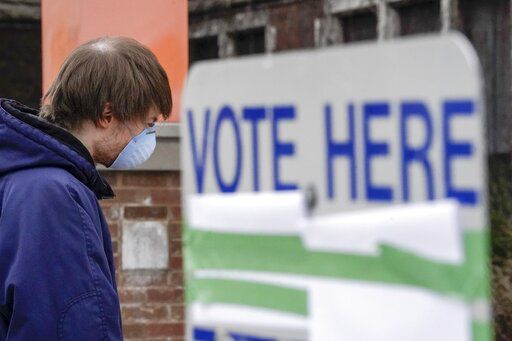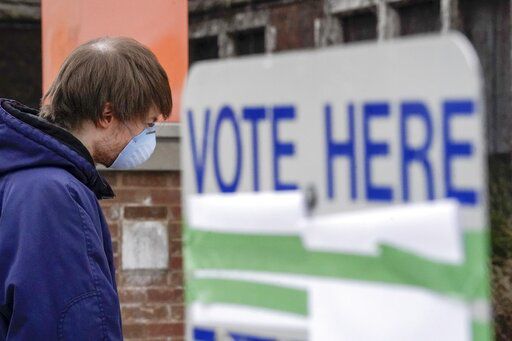Elections Commission approves sending absentee ballot applications to 2.7 million

Voters line up at Milwaukee Riverside High School for Wisconsin’s April 7 primary election.
Morry Gash, Associated Press
More than 2.7 million Wisconsinites will receive an absentee ballot application and other vote-by-mail information ahead of the November election, even as President Donald Trump has launched a campaign against expanding voting by mail.
The Wisconsin Elections Commission unanimously approved a plan Wednesday that would send 80% of the state’s 3.4 million total registered voters a letter with a form allowing them to request an absentee ballot.
It would also provide them with information on how to request a ballot online, using the MyVote Wisconsin website, the legal requirements to vote absentee, as well as in-person voting options to reduce voter confusion during the COVID-19 pandemic.
The plan uses about $2.3 million of the $7.3 million in federal COVID-19 funding given to the commission to address challenges for the August and November elections. Commissioners unanimously signed off on the $2.3 million for the program, but will still need to meet in June to approve the contents of the mailing.
Democrats on the commission expressed concerns they’ll be unable to reach a consensus with Republicans on the wording of the letter. Because the commission consists of three Democrats and three Republicans, any motion requires at least one vote from across the aisle to succeed.
The adoption of the plan by the state’s elections agency comes as Trump has turned up the dial on his rhetoric against voting by mail as it becomes an attractive option for the November election in order to prevent crowding at the polls during the pandemic.
Trump has falsely claimed voting by mail is ripe for fraud and that states promoting absentee voting had acted illegally. Despite Trump’s qualms with voting by mail, political scientists say there’s no correlation between levels of absentee or mail voting and partisan advantage.
Absentee plan
Excluded from the 2.7 million recipients of the mailing are the 528,000 voters who have already requested an absentee ballot for an upcoming election this year, and 158,000 voters who the state suspects have moved addresses.
Elections officials are anticipating numerous challenges for the August and November elections following the April 7 election, which provided a test run of how to conduct an election in a pandemic. In that election, Wisconsinites requested absentee ballots in record numbers to avoid showing up at the polls and risking their health. State officials estimate as many as 1.8 million Wisconsinites could request an absentee ballot ahead of the November election.
Commission chairman Dean Knudson, a Republican, had wanted to further exclude people who live in municipalities that are sending out their own absentee ballot applications, but failed to get bipartisan support because Democrats wanted the mailings to be consistent statewide.
In addition to sending voters an application, the plan also somewhat centralizes the processing of absentee ballot requests. The commission proposed hiring additional temporary staff or working with a data warehouse to receive the mailed forms and enter them into the online MyVote system, as well as scan in photo ID and other application materials. The goal is to alleviate the strain on local clerks who may again face unprecedented absentee ballot requests.
The commission anticipates about 1% of the applications will be completed and returned, or about 27,140 voters.
Clerks would still be responsible for ultimately approving the request. The process also would allow Elections Commission temporary staff to notify voters if the photo ID they submitted in their request was rejected, in order to free up clerks’ time.
The plan has garnered pushback from some state Republicans. When commissioners debated the plan last week, Senate Majority Leader Scott Fitzgerald, R-Juneau, urged commissioners to reject the absentee ballot application proposal, citing concerns with centralizing absentee voting in Madison. He said such funding should instead go toward local clerks to help them hire extra staff and expand hours for early in-person voting.
He also cited concerns with sending ballots to a voter list “that we know has not been cleaned up,” referring to the thousands of voters who may have moved, but remain on voters rolls. An attempt to purge those names from voting rolls is being litigated in state courts.
Other spending
Commissioners on Wednesday also approved plans to spend most of the remaining $7.3 million in federal COVID-19 funding on grants to local elections officials. The $4.1 million in block grants to those officials gives them more autonomy than the commission’s original plan, which would have targeted the funding for specific purposes.
Local elections officials can use their portion of the $4.1 million for unbudgeted costs related to COVID-19 for upcoming elections. Examples of how the funding can be used include additional ballot supplies, printing and postage costs, additional cleaning supplies and protective equipment, more staff for processing more absentee ballots, public communications on changes to the voting process, additional absentee drop-box installation, additional leasing of polling places when existing sites are closed or relocated, and additional equipment to process absentee ballots.
Last week, commissioners already approved $500,000 of the funding for local clerks to secure sanitation supplies, such as hand sanitizer, for upcoming elections.
Wednesday’s action by the commissioners will also provide $400,000 to allow the commission to incorporate intelligent mail bar codes into the existing absentee ballot design to better track absentee ballots following trouble in some municipalities with ballots arriving on time.
The Elections Commission will be able to use the remaining funding to reimburse costs incurred for pandemic-related work.








